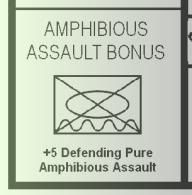Well the idea was to take all the “at war” related NOs and just streamline them into a single simple to remember rule with a straight forward easy to remember bonus. G40 is poorly balanced to begin with. I wouldn’t suggest this as the sole corrective for game balance, since clearly, if you want a game balanced by side, you’re going to have to tweak the board in more ways than this. I just find it annoying how for example, Russia has no incentive not to declare on Japan immediately, or how there is no mechanism to support neutrality in so many instances with various powers. Even if the decision to declare is still fairly obvious, at least this gives you something to consider, and something that holds for both sides along a neutrality pact, instead of so many 1 sided DoW bonuses. There are a bunch of silly NOs that seem to exist for no other reason than to give certain nations +5 here and there. I’d just as soon ditch all of them in favor of a single rule that handles neutrality across the board.
I think it might be novel if this included a nod to the pro - side neutrals too. But again, I don’t see this as necessarily a balance driver, more something I prefer for rules consistency with all powers.
When you get down to it, I just don’t think the DoW bonuses +5, belong in the National Objectives list. They cannot be contested the way other NOs can, and the way they are worded OOB, these objectives don’t seem to drive the gameplay in a very meaningful way. I would seperate them off from the other NOs and provide a universal rule that can be handled in a line or two, applying to everyone equally. Then replace the existing Neutrality/DoW NOs currently in G40 OOB, with some NOs that are more interesting as gameplay drivers.
My usual approach for Axis and Allies, going back to AA50 and now with G40, is to replace specific National Objectives, with universal or general Objectives that accomplish similar gameplay effects whenever possible, since I believe the latter are better for the game flow and easier to remember. Basically if you can replace half a dozen Nation Objectives, with a single General Objective (that applies the same way for all nations) that is ideal.
Thus far I have used this neutrality bonus idea, in conjunction with a VC bonus idea, and a few others to more less strip G40 of “national” objectives altogether. Then if you wanted to bring NOs back into play, to do something more streamlined, with just 1 or 2 high value NO per nation, on areas of the board where the gameplay/strategic interest would benefit from their inclusion.
Along these lines, for consistency and to provide additional income for Germany and Italy, it might make sense to include China in the neutrality rules. I gripe on China constantly, but in this case you’d have a potential +10 for both sides if G/I opt not to declare on it. Axis would have to decide if they want the extra in Europe, but only at the risk of a stronger China vs Japan. Which might have an interesting effect on balance. I’ll edit to the lead post to reflect this option.







